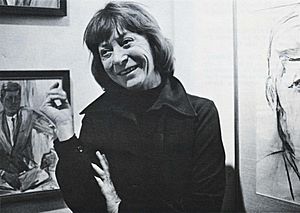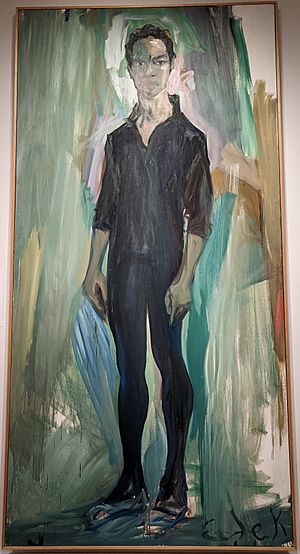Elaine de Kooning facts for kids
Quick facts for kids
Elaine de Kooning
|
|
|---|---|

Elaine de Kooning circa 1974
|
|
| Born |
Elaine Marie Catherine Fried
March 12, 1918 Brooklyn, New York
|
| Died | February 1, 1989 (aged 70) Southampton, New York
|
| Nationality | American |
| Known for | Painting |
| Movement | New York Figurative Expressionism, Abstract Expressionism |
| Spouse(s) | Willem de Kooning |
Elaine Marie Catherine de Kooning (born Fried; March 12, 1918 – February 1, 1989) was an important Abstract Expressionist and Figurative Expressionist painter. She lived and worked after World War II. Elaine also wrote a lot about art during her time. She was an editor for Art News magazine.
Contents
Early Life and Art Start
Elaine de Kooning was born Elaine Marie Catherine Fried in 1918 in Flatbush, New York. She was the oldest of four children. Her mother, Mary Ellen O'Brien, and father, Charles Frank Fried, supported her interest in art.
Elaine's mother took her to museums when she was only five years old. She taught Elaine how to draw what she saw. Elaine's childhood room was even decorated with copies of famous paintings.
School Days and Art Training
When Elaine was in grade school, she started drawing and selling portraits of other children. She was good at both sports and art. Elaine went to Erasmus Hall High School in Brooklyn.
After high school, she studied math for a short time at Hunter College in New York City. There, she met a group of abstract and Social Realist painters. In 1937, she went to the Leonardo da Vinci Art School. She also studied at the American Artists School in New York City. While in school, Elaine worked as an art model to earn money.
Meeting Willem de Kooning
In 1938, when Elaine was 20, her teacher introduced her to Willem de Kooning. He was 34. Elaine already admired his art. After they met, Willem started teaching her how to draw and paint. They painted together in his studio. Willem was very strict about her work. He would often make her draw things again and again. He even destroyed some of her drawings. But this pushed Elaine to make her art very precise and beautiful.
They got married on December 9, 1943. Elaine moved into his studio, and they continued to share their art spaces. The couple separated in 1957 but got back together in 1976.
Elaine's Art Career
Elaine de Kooning was a talented artist who painted landscapes and portraits. She was part of the Abstract Expressionist art movement in the mid-1900s. She was also a member of the Eighth Street Club in New York City. This club was a place where artists could talk about their ideas. It was rare for a woman to be a member at that time.
Elaine worked hard to promote her husband Willem's art. She was very serious about her own paintings, but she knew they were often less famous than his. In 1951, she showed her work with Willem's in an exhibition called Artists: Man and Wife. She later felt that the show made the women artists seem less important than their husbands. Even so, Elaine kept supporting Willem's career.
In 1954, Elaine had her first solo art show at the Stable Gallery. Women artists were often not given enough credit in the Abstract Expressionist movement. To avoid her paintings being seen as "feminine" in a mostly male art world, Elaine signed her artworks with her initials instead of her full name. This also helped avoid confusion with her husband.
Elaine de Kooning was also an important writer and teacher. She started working at ARTnews magazine in 1948. She wrote about many famous artists. She wrote about one hundred articles for the magazine. Elaine was the first American artist in the 1950s to write art reviews. She wrote about culture, art, and new ideas. Even though she was a successful writer, Elaine always thought of herself as a "painter by nature."
She taught art at many colleges and universities. After she and Willem separated in 1957, she took teaching jobs to support herself. She taught at places like the University of New Mexico, Carnegie Mellon, Yale University, and the RISD. In 1985, she became a member of the National Academy of Design.
In 2016, Elaine de Kooning was part of a special exhibition called "Women of Abstract Expressionism." This show highlighted the amazing talents of female artists who were often overlooked.
Her Art Style
Elaine de Kooning created both abstract and figurative paintings and drawings. She painted still lifes, city scenes, and portraits. Her art was influenced by artists like Willem de Kooning. Her early works included watercolors and still lifes. Later, her art mixed abstract ideas with myths, ancient images, and realism.
She was known for her unique way of painting portraits. Even though her work was mostly about real figures, it was rarely completely abstract. She made sculptures, etchings, and art inspired by cave drawings. Her art combined painting and drawing, colors and light, and different textures.
When asked about her style, she said, "I'm more interested in character than style. Character comes out of the work. Style can be a prison."
Early Artworks
In the summer of 1948, Elaine and Willem de Kooning spent time at Black Mountain College in North Carolina. Elaine studied with famous artists and thinkers there. She was very involved in the college's social life and often took part in plays.
Famous Portraits
A big part of Elaine de Kooning's work was painting portraits. She painted many self-portraits. Her subjects were often other artists, mostly men. These included poets like Frank O'Hara, dancers like Merce Cunningham, and art dealers like Leo Castelli. She also painted the famous Brazilian soccer star, Pele. Even though she used a free, expressive style, she always made sure the person looked like themselves.
In 1944, Elaine met artist Joop Sanders. They agreed to pose for each other. This led to many portraits. Elaine called her paintings of him the "Joop Paintings." She would spend a day drawing him, then a week turning the drawings into a painting. She said she became "hooked" on portraits. She blended parts of the person she was painting with parts of herself.
Elaine used many different drawing and painting methods. She made detailed pencil drawings and free ink drawings. She used thin paint and thick paint, and many materials like pencil, ink, charcoal, and oil.
She was very good at showing people's faces and their presence with quick, strong paint strokes. For example, a drawing of her brother Conrad from 1951 shows his head and shoulders against a dark background. She used careful lines and darker strokes to create a thoughtful figure.
Elaine de Kooning once wrote about her portraits: "Portraiture always fascinated me because I love the particular gesture of a particular expression or stance." She studied each person to find the pose that best showed who they were.
One of her most important projects was a series of portraits of President John F. Kennedy. She also painted men with children and a series of women after Kennedy's death.
New Mexico Inspired Art
From 1958 to 1959, Elaine taught as a visiting professor at the University of New Mexico. This allowed her to experience the bright colors and wide-open spaces of the Southwest. She visited Juarez, Mexico, and saw many bullfights. She then created a series of paintings about bullfighting using bold, bright colors. She loved the "overwhelming gold" of the trees and how the mountains seemed to "move toward you." She also visited artist Georgia O'Keeffe in Santa Fe.
During this time, she started trying out acrylic paint. She also made friends with other artists and students.
Bacchus Series
The Bacchus series of paintings and watercolors started in 1976 and lasted for seven years. Elaine de Kooning was inspired by a 19th-century sculpture of the Roman god Bacchus. She saw it in the Luxembourg Gardens in Paris. She loved the sculpture's twisting, energetic shape, which showed the wildness of the god and his friends. This was the first time she used acrylic paint.
Later Artworks
In 1983, Elaine visited ancient cave paintings in France (Lascaux) and Spain (Altamira). These visits inspired a series of paintings called Cave Walls. She felt that ancient cave art was similar to Abstract Expressionism. Both used spontaneous and improvisational techniques. She saw that "Paleolithic art [was] close in spirit to twentieth-century art."
When she visited the cave in the Spanish Pyrenees in 1985, she noticed that the cave walls' textures were like the backgrounds of her own paintings. This made her feel confident in her unique way of working. These paintings were shown in an exhibition just three months before she passed away.
Art Exhibitions
De Kooning's art has been shown in many solo exhibitions and group shows. Her work has become more recognized since her death. For example, the "Elaine De Kooning: Portraits" exhibition was held at the National Portrait Gallery in Washington, D.C., in 2015.
Teaching Jobs
Elaine de Kooning taught at many famous universities during her life:
- 1958–59: University of New Mexico
- 1960: The Pennsylvania State University
- 1963–64: University of California Davis
- 1967: Yale University
- 1968: Pratt Institute
- 1968–70: Carnegie-Mellon University
- 1971–72: University of Pennsylvania
- 1971: Wagner College
- 1974: New York Studio School
- 1974–75: Parsons School of Design
- 1976–79: University of Georgia
Where to See Her Art
Elaine de Kooning's important artworks are in the permanent collections of many museums:
- The Museum of Modern Art, New York, NY
- The Solomon R. Guggenheim Museum, New York, NY
- The Metropolitan Museum of Art, New York, NY
- The Denver Art Museum, Denver, CO
- The National Academy Museum and School, New York, NY
- The Los Angeles County Museum of Art (LACMA), Los Angeles, CA
- The National Portrait Gallery, Washington, D.C.
- Guild Hall Center for the Visual and Performing Arts, East Hampton, Long Island, NY
- The National Museum of Women in the Arts, Washington, D.C.
The Smithsonian Institution's National Portrait Gallery has the largest collection of her portraits in a museum.
Her Passing
Elaine de Kooning passed away on February 1, 1989, in Southampton, New York. She was 70 years old.
Her Lasting Impact
Elaine de Kooning's work continues to be important. In 1972, artist Mary Beth Edelson created a famous artwork called Some Living American Women Artists / Last Supper. It showed notable women artists, including Elaine, in a new version of Leonardo da Vinci's The Last Supper. This artwork became a symbol of the feminist art movement.
In 2015, the Pollock-Krasner House and Study Center had an exhibition called "Elaine de Kooning Portrayed." It showed portraits and ideas about Elaine by other artists, including her husband Willem.
Elaine de Kooning owned a studio in East Hampton. Today, the owners are planning to turn it into an art residency space called "the Elaine de Kooning house."
See also
 In Spanish: Elaine de Kooning para niños
In Spanish: Elaine de Kooning para niños
- Women in art
- American Figurative Expressionism
- New York Figurative Expressionism
- New York School



